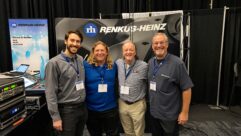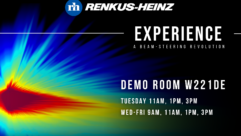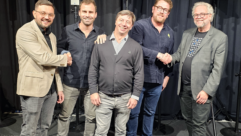
Los Angeles, CA—July 2017…Housed in a new, 70-foot-tall, 54,000-square-foot building designed by local architect William Murray of Pfeiffer Partners, Inc., University of Southern California’s $46 million Glorya Kaufman International School of Dance features a large performance studio, four medium dance studios, and one upper division studio. To ensure that the audio and video systems met Pfeiffer Partner’s quality standards and the University’s functional expectations, Pfeiffer Partners, Inc., hired San Luis Obispo, California, electro-acoustic consultant Rick Wells of Multi-Media Consulting, Inc. Wells designed, and ProSound installed, a system based on Renkus-Heinz loudspeakers using a scalable system concept that is custom-configured for the specialized needs of each space.

“I designed several scalable systems to accommodate the different rooms’ variations and functional requirements,” Wells observes. “I wanted all of the studios to function and sound similar, so that instructors and students can easily move from studio to studio. Ralph Heinz was first loudspeaker designer to recognize the needs of consultants and give us these types of tools so we can achieve complex goals in system design.”
The 60 x 40-foot medium dance studios are designed with Renkus-Heinz RH123 three-way point-source reinforcement systems and a PN112 subwoofer. “The RH123 is one of my favorite loudspeakers,” Wells explains. “They are compact, sound natural, and are available with multiple horn patterns. This lets me use the same loudspeaker in multiple room with different sizes and shapes. The CDT-3 mid/high driver uses a 3-inch compression driver and 6.5-inch mid driver in a coentrant configuration that gives me the ability to control the pattern of coverage down to 300 Hz with predictable results. The compression driver has a relatively low compression ratio that produces an overall natural, open sound.”
Wells designed a separate speech-reinforcement system to assist the instructors when teaching for hours in loud environments. “I did not want to use the program audio speakers for speech, so I designed an autonomous speech-reinforcement system. I included a wireless microphone and a simple mixer, and I used a single Renkus-Heinz TRX62H, located above the instructor, for the best coherence without the possibility of comb filtering. The TRX62H has a very wide horizontal dispersion.” The Renkus-Heinz TRX62H two-way Complex Conic loudspeaker system features dual 6.5-inch, heavy-duty, low-frequency drivers and a 1-inch, extended-range, titanium HF driver that offers 150° by 60° coverage. The system is a simple, elegant, compact solution.
The large performance studio presented a unique set of requirements. “The large studio doubles as a theater and practice space, requiring a more elaborate system,” Wells explains. “We continued the scalable system concept in the large dance studio. There’s a system for the audience and a separate system for instructional use. In Performance mode, portions of the instructional system are used for theatrical effects and as dance monitors. I designed an LCR main system for the audience with three Renkus-Heinz RH153 three-way Complex Conic loudspeakers, configured with a 15-inch woofer and the same CDT-3 mid-high device that is in the RH123. We route speech through the center channel and program audio through the left and right loudspeakers. We used a Renkus-Heinz DR18-2R direct-radiating subwoofer, configured with dual 18-inch drivers crossed over at 80 Hz, to reinforce the extreme low end of the audio spectrum.”

Wells specified a pair of Renkus-Heinz RH123s as rear surrounds for theatrical effects. Two more RH123s are located behind the flexible proscenium, aimed at the dancers as monitors. “ProSound programmed the DSP so they can use one rear RH123 for theatrical effects with a dance monitor on stage,” Wells notes. “That way, they can use the performance studio system like any other dance studio. There’s a portable version of the medium dance studio system on a cart, and the instructors can plug into that. Using a Crestron system, they can change how the room functions from performance mode to dance mode.”
All audio systems throughout the building are networked over Dante and can operate as one system, using a pair of QSC Q-SYS DSPs. “The DSPs can be used in the theater as a live performance system, with a Dante-enabled Yamaha mixer, or as an automated system,” Wells details. “The system includes production communications intercommand production video, networked from the large performance theater into the medium and small dance studios so we can use the studios as staging areas for larger performances. A separate system on the same network distributes audio to the lobbies, restrooms, and the exterior courtyard.”
The carefully chosen point-source systems and subwoofers, separate speech systems in the individual studios, theater surrounds in the performance studio, extensive networking, and easy-to-use controls all reflect Wells’ keen awareness of a dance school’s specialized needs. The results speak for themselves. “The building is still brand new,” he reminds. “But so far, the school’s staff is extremely happy with their Renkus-Heinz systems.”









